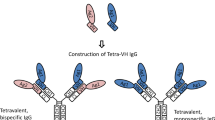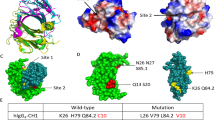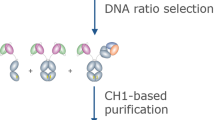Abstract
Production of bispecific IgG (BsIgG) by coexpressing two different antibodies is inefficient due to unwanted pairings of the component heavy and light chains. To overcome this problem, heavy chains were remodeled for heterodimerization using engineered disulfide bonds in combination with previously identified “knobs-into-holes” mutations. One of the variants, S354C:T366W/Y349′C:T366′S:L368′A:Y407′V, gave near quantitative (∼95%) heterodimerization. Light chain mispairing was circumvented by using an identical light chain for each arm of the BsIgG. Antibodies with identical light chains that bind to different antigens were identified from an scFv phage library with a very restricted light chain repertoire for the majority (50/55) of antigen pairs tested. A BsIgG capable of simultaneously binding to the human receptors HER3 and cMpI was prepared by coexpressing the common light chain and corresponding remodeled heavy chains followed by protein A chromatography. The engineered heavy chains retain their ability to support antibody-dependent cell-mediated cytotoxicity as demonstrated with an anti-HER2 antibody.
This is a preview of subscription content, access via your institution
Access options
Subscribe to this journal
Receive 12 print issues and online access
We are sorry, but there is no personal subscription option available for your country.
Buy this article
- Purchase on SpringerLink
- Instant access to full article PDF
Prices may be subject to local taxes which are calculated during checkout
Similar content being viewed by others
References
Holliger, P. and Winter, G. 1943. Engineering bispecific antibodies. Current Opin Biotechnol. . 4: 446–449.
Carter, P., Ridgway, J. and Zhu, Z. 1995. Toward the production of bispecific antibody fragments for clinical applications. J Hematother . 4: 463–470.
Plückthun, A. and Pack, P. 1997. New protein engineering approaches to multivalent and bispecific antibody fragments. Immunotechnology. 3: 83–105.
Milstem, C. and Cuello, A.C. 1983. Hybrid hybnodomas and their use in immunohistochemistry. Nature 305: 537–540.
Suresh, M.R., Cuello, A.C. and Milstem, C. 1986. Bispecific monoclonal antibodies from hybrid hydndomas. Methods Enzymol.121: 210–228
Ridgway, J.B.B., Presta, L.G. and Carter, P. 1996. “Knobs-mto-holes” engineering of antibody CH3 domains for heavy chain heterodimenzation. Protein Eng. 9: 617–621
Atwell, S., Ridgway, J.B.B., Wells, J.A. and Carter, P. 1997. Stable heterodimers from remodeling the domain interface of a homodimer using a phage display library. J Mol Biol. 270: 26–35
Villafranca, J.E., Howell, E.E., Voet, D.H., Strobel, M.S., Ogden, R.C., Abelson, J.N. and Kraut, J. 1983. Directed mutagenesis of dihydrofolate reductase. Science . 222: 782–788
Perry, L.J. and Wetzel, R. 1984 Disulfide bond engineered into T4 lysozyme stabilization of the protein toward thermal inactivation. Science. 276: 555–557
Wells, J.A. and Powers, D.P. 1986 In vivo formation and stability of engineered disulfide bonds in subtihsm. J Biol Chem. 261: 6564–6570
Nissim, A., Hoogenboom, H.R., Tomlmson, I.M., Flynn, G., Midgley, C., Lane, D. and 1994 Antibody fragments from a “single pot” phage display library as immunochemical reagents. EMBOJ. 13: 692–698
Vaughan, T.J., Williams, A.J., Pntchard, K., Osbourn, J.K., Pope, A.R., Earnshaw
Sriravasan,N., Sowdhammi, R., Ramaknshnan, C., and Balaram, P 1990 Conformations of disulfide bridges in proteins Int J Peptides Protein Res 36:147–155
Chamow, S M, Zhang, D Z, Tan, X Y, Mhatre, S M, Marsters, S A, Peers, D H et al 1994 A humanized, bispecific immunoadhesin-antibody that re_targets CD3+ effectors to kill HIV-1-infected cells J Immunol 153:4268–4280
Plowman, G D Whitney, G S, Neubauer, M G, Green, J M, McDonald, V.L., Todaro, G J, and Shoyab, M 1990 Molecular cloning and expression of an additional epidermal growth factor receptor-related gene Proc Natl Acad Sci USA 87:4905–4909
Carter, P Presta, L, Gorman, C M, Ridgway, J B B, Henner, D, Wong, W L T, et al 1992 Humanization of an anti-p185HER2 antibody for human cancer therapy Proc Natl Acad Sci USA 89:4285–4289
Lewis G.D., Figan, I, Fendly, B Wong, W.L., Carter, P, Gorman, C, and Shepard, H M 1993 Differential responses of human tumor cells lines to anti-pi 185HER2 monoclonal antibodies Cancer Immunol Immunother 37:255–263
Deisenhofer, J 1981 Crystallographic refinement and atomic models of a human Fc fragment and its complex with fragment B of protein A from Staphylococcus aureus at 2 9- and 2 8 Å resolution Biochemistry 20:2361–2370
Kabat E A, Wu, T.T., Perry, H M, Gottesman, K S, and Foeller, C (eds) 1991 pp 688–696 in Sequences of proteins of immunological interest, 5th ed, Vol 1 NIH Bethesda, MD
Miller, S 1990 Protein-protein recognition and the association of immunoglobu-lin constant domains J Mol Biol 216:965–973
Dietsch, M T, Smith, V.F., Cosand, W L, Damle, N K, Ledbetter, J A, Lmsiey, P.S., and Aruffo, A 1993 Bispecific receptor globulins, novel tools for the study of cellular interactions Preparation and characterization of an E-selectm/P-selectm bispecific receptor globulin J Immunol Methods 162:123–132
Hale, G, Dyer, M J S Clark, M R, Phillips, J M, Marcus, R, Riechmann, L et al 1988 Remission induction in non-Hodgkm lymphoma with reshaped human monoclonal antibody CAMPATH 1H Lancet 2:1394–1399
Caron, P.C., June, J G, Scott, A M, Finn, R D, Divgi, R D Graham, M C et al 1994 A phase 1B tnal of humanized monoclonal antibody M195 (anti-CD33) in myeloid leukemia specific _targeting without immunogenicity Blood 83:1760–1768
Sharkey R M, Malik, J, Shevitz, J, Behr, T, Dunn, R, Swayne, L C et al 1995 Evaluation of a complementarity-determining region-grafted (humanized) anti-carcmoembryonic antigen monoclonal antibody in preclinical and clinical stud les Cancer Res 55:5935s–5945s
Baselga, J, Tnpathy, D, Mendelsohn, J, Baughman, S, Benz C C, Dantis, L et al 1996 Phase II study of weekly intravenous recombmant humanized anti-pi 185HER2 monoclonal antibody in patients with HER2/neu-overexpressmg metastatic breast cancer J Clin Oncol 14:737–744
Isaacs, J D, Watts, R A, Hazleman, B L, Hale, G, Keogan, M T, Cobbold, S P, and Waldmann, H 1992 Humanised monoclonal antibody therapy for rheumatoid arthritis Lancet 340:748–752
Vmcenti, F, Lantz, M, Bimbaum, J, Garovoy, M, Mould, D, Hakimi, J et al 1997 A phase I trial of humanized anti-mterleukin 2 receptor antibody in renal transplantation Transplantation 63:33–38
Yang, W -P, Green K, Pinz Sweeney, S, Bnones, A T, Burton, D R, and Barbas C F 1995 CDR walking mutagenesis for the affinity maturation of a potent human anti-HIV-1 antibody into the picomolar range J Mol Biol 254:392–403
Schier, R, McCall, A, Adam, G P, Marshall, K W, Memtt, H, Yim M et al 1996 Isolation of picomolar affinity anti-c-erbB-2 single-chain Fv by molecular evolution of the complementarity determining regions in the center of the antibody binding site J Mol Biol 263:551–567
Figini, M, Marks, J D, Winter, G and Griffiths, A D 1994 In vitro assembly of repertoires of antibody chains on the surface of phage by renaturation J Mol Biol 239:68–78
Rodngues, M L, Presta, L G, Kotts, C E, Wirth, C, Mordenti, J, Osaka, G et al 1995 Development of a humanized disulfide-stabilized anti-p185HER2 Fv p-lacta-mase fusion protein for activation of a cephalosponn doxorubicm prodrug Cancer Res 55:63–70
Kunkel, T.A., Roberts, J D, and Zakour, R A 1987 Rapid and efficient site-specific mutagenesis without phenotypic selection Methods Enzymoi 154:367–382
Sanger, F, Nicklen, S and Coulson, A R 1977 DNA sequencing with chain terminating inhibitors Proc Natl Acad Sci USA 74:5463–5467
Gorman, C M, Gies, D R, and McCray, G 1990 Transient production of proteins using an adenovirus transformed cell line DNA and Protein Engmeenng Techniques 2:3–10
Presta, L G, Lahr, S J, Shields, R L, Porter, J P, Gorman, C M, Fendly, B M, and Jardieu, P M 1993 Humanization of an antibody directed against IgE J Immunol 151:2623–2632
Byrn, R A, Mordenti, J, Lucas, C, Smith, D, Marsters, S A, Johnson, J S et al 1990 Biological properties of a CD4 immunoadhesm Nature 344:667–670
Marks J D, Hoogenboom, H R, Bonnert, T P, McCafferty, J Griffiths, A D, and Winter, G 1991 By-passing immunization Human antibodies from V-gene libraries displayed on phage J Mol Biol 222:581–597
Feng, D F and Doolittie, R F 1985 Aligning ammo acid sequences comparison of commonly used methods J Mol Evol 21:112–123
Feng, D F and Doolittie, R F 1987 Progressive alignment as a prerequisite to correct phylogenetic trees J Mol Evol 25:351-360
Feng, D F and Doolittie, R F 1990 Progressive alignment and phylogenetic tree construction of protein sequences Methods Enzymol 183:375–387
Xie, M H, Yuan, J, Adams, C, and Gurney, A 1997 Direct demonstration of MuSK involvement in acetylcholme receptor clustering through identification of agonist ScFv Nature Biotechnology 15:768–771
Author information
Authors and Affiliations
Rights and permissions
About this article
Cite this article
Merchant, A., Zhu, Z., Yuan, J. et al. An efficient route to human bispecific IgG. Nat Biotechnol 16, 677–681 (1998). https://doi.org/10.1038/nbt0798-677
Received:
Accepted:
Issue Date:
DOI: https://doi.org/10.1038/nbt0798-677
This article is cited by
-
An RBD bispecific antibody effectively neutralizes a SARS-CoV-2 Omicron variant
One Health Advances (2023)
-
Harnessing ceramic hydroxyapatite as an effective polishing strategy to remove product- and process-related impurities in bispecific antibody purification
Bioresources and Bioprocessing (2023)
-
Design of an alternate antibody fragment format that can be produced in the cytoplasm of Escherichia coli
Scientific Reports (2023)
-
Inadequate structural constraint on Fab approach rather than paratope elicitation limits HIV-1 MPER vaccine utility
Nature Communications (2023)
-
Effective clearance of rituximab-resistant tumor cells by breaking the mirror-symmetry of immunoglobulin G and simultaneous binding to CD55 and CD20
Scientific Reports (2023)



